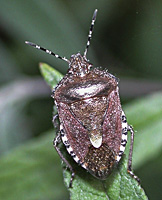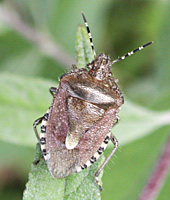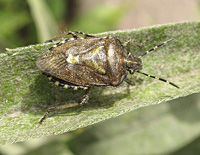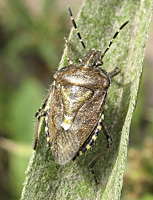[All pictures of garden wildlife on this page are thumbnails. Click on any thumbnail for a large format to be displayed.]
The Sloe Bug (Dolycoris baccarum)
The Sloe Bug is a rather variable creature. The basic colour is a kind of dark Burgundy red with a fine, black punctation. The end of the scutellum is always bright yellowish white and not punctuated. The remainder of the scutellum is extremely variable in colour: sometimes burgundy red just as the rest of the bodu, but usuallly yellowish or greenish. Still this is an umistakable species, because it is one of the very few shield bugs in our part of the world with antennae ringed like this.The rings are about both the end of one segment and the beginning of the next. This way they give the impression of being "double". The length is quite characteristic for our Shield Bugs: some 10 to 15mm.
The eggs are deposited in spring. In summer we'll see the larvae of the Sloe Bug on various plants, especially those of the Rose-family. Neither the larvae nor the adults have ever been seen feeding on Sloe. The background of the vernacular name is stowed away in darkness. The larvae of the Sloe Bug are similar to the larvae of the Green Shieldbug, except for the basic colour being brown. By the end of summer the adults appear. As they are able to fly about, they can soon be found on shrubs bearing berries. Flying is painfully slow while producing a low humming sound. The adult animals overwinter.
Of all the stink bugs this one is the worst. It really loves berries, especially Honeysuckle and Raspberries. It walks all over them, leaving behind an awful stinking substance. This makes all berries it walked over inedible. Like in other Stink Bugs the substance is made for protection. A bird or other enemy will eat only one bug in its entire live. Afterwards it will always remember the dreadful taste and will never touch another bug again.
The Sloe Bug is a very common bug in southern parts of Engeland and Wales, getting scarcer going northwards. Not found in Scotland. Common over most of Europe and Central Asia, but not in northern areas. Not only found in fields, but in forests, parks and gardens too, sometimes in great numbers. Usually not as abundant as the Green Stinkbug.
The Sloe Bug is sometimes called the Hairy Bug, which actually is a more suitable name.
The eggs are deposited in spring. In summer we'll see the larvae of the Sloe Bug on various plants, especially those of the Rose-family. Neither the larvae nor the adults have ever been seen feeding on Sloe. The background of the vernacular name is stowed away in darkness. The larvae of the Sloe Bug are similar to the larvae of the Green Shieldbug, except for the basic colour being brown. By the end of summer the adults appear. As they are able to fly about, they can soon be found on shrubs bearing berries. Flying is painfully slow while producing a low humming sound. The adult animals overwinter.
Of all the stink bugs this one is the worst. It really loves berries, especially Honeysuckle and Raspberries. It walks all over them, leaving behind an awful stinking substance. This makes all berries it walked over inedible. Like in other Stink Bugs the substance is made for protection. A bird or other enemy will eat only one bug in its entire live. Afterwards it will always remember the dreadful taste and will never touch another bug again.
The Sloe Bug is a very common bug in southern parts of Engeland and Wales, getting scarcer going northwards. Not found in Scotland. Common over most of Europe and Central Asia, but not in northern areas. Not only found in fields, but in forests, parks and gardens too, sometimes in great numbers. Usually not as abundant as the Green Stinkbug.
The Sloe Bug is sometimes called the Hairy Bug, which actually is a more suitable name.

© Copyright 1998-2024 gardensafari.net (Hania Berdys)

 English / engels
English / engels  Dutch / nederlands
Dutch / nederlands






